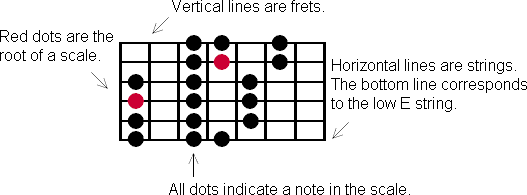Reading Fretboard Diagrams
The scales in the scale pattern library are presented in tablature and as fretboard diagrams. If you haven't encountered fretboard diagrams before, they may look confusing. They also work a bit differently than chord diagrams, so even if you have read chord diagrams, you may not be able to read scales in fretboard diagram without an explanation. Below is a detailed breakdown of how to read the fretboard diagrams in this section. Note that scale diagrams outside of this site may differ slightly. However, with the information below, you should be able to figure out differences in other scale diagrams pretty easily.
Parts of a Fretboard Diagram
The Lines
A fretboard diagram is a combination of horizontal and vertical lines. Horizontal lines represent guitar strings, with the bottom line in the diagram corresponding to the low E string. All the lines above this follow the normal order of strings (EADGBE).
Vertical lines are frets.
Dots
Dots are placed on the fretboard on a specific horizontal lines and between two vertical lines. This indicates the exact fret and string where a note in the scale occurs. Unlike chord diagrams, multiple notes may occur on the same string with a scale.
Red dots are used to indicate the root of a scale. The root will occur multiple times in most scale patterns, so there will usually be at least two red dots in each pattern.
Below is a fretboard diagram for a major scale with each of the parts labeled:

